

 | Molecular & Cellular Biomechanics |  |
DOI: 10.32604/mcb.2022.018558
ARTICLE
Analysis of Biomechanical Characteristics of Football Players at Different Levels Kicking with the Inner Edge of Instep
Anshan Normal University, Anshan, 114007, China
*Corresponding Author: Enhua Li. Email: euv48m@163.com
Received: 02 August 2021; Accepted: 30 September 2021
Abstract: This study aims to analyze the difference in biomechanical properties of football players at different levels when kicking the football with the inner edge of the instep. Before the experiment, ten football players were selected; five were higher than the national level (group A), and the other five players were lower than the national level II (group B). During the experiment, the motion process was captured by a high-speed camera for biomechanical analysis. It was found that in group A, the thigh and leg swung in less time and larger amplitude, the acceleration of backswing and forward swing of the leg was larger, and the angular velocity of forward swing was also larger. At the moment of touching the ball, in the sagittal plane, the ankle joint angle and angular velocity of group A were larger than those of group B (P < 0.05). In conclusion, the high-level athletes can complete the high-quality kicking through a larger swing amplitude and speed of the kicking leg. In the training process, the athletes should pay attention to the speed and strength of the kicking leg to improve the kicking level.
Keywords: Instep; biomechanics; ankle joint; swing speed; football player
In sports, how to improve the technical level of athletes to increase the chance of winning and reduce exercise-induced injuries is the focus of athletes and coaches [1]. In the past, the coach’s guidance is dependent on long-term experience, with strong subjectivity, which cannot provide targeted guidance to athletes. The analysis of biomechanical characteristics has a great role in mastering the technical characteristics of athletes [2] and can greatly promote the development of sports [3]. With the development of technology, instruments such as high-speed cameras [4], sensors [5], electromyogram (EMG) system [6], and dynamometer [7] have been well applied in the field of sports, showing high reliability in mining athletes’ movement characteristics and analyzing biomechanical characteristics [8]. Wang et al. [9] analyzed the injury of javelin athletes with the biomechanical method. The investigation of 50 athletes found that the extension of athletes’ left leg might be the factor of injury. Stephens et al. [10] studied the influence of ankle binding on the joints of female basketball players when they did the backboard cutting action. The experiment found that ankle binding significantly reduced the maximum peak dorsiflexion of the ankle joint and the range of motion but increased the internal rotation torque of the knee joint, indicating that ankle binding might not be conducive to the safety of the knee joint. Gillet et al. [11] studied the influence of lower trapezius muscle weakness on the human body in tennis, compared the service effect before and after the selective fatigue of lower trapezius, and found that fatigue led to a decrease of 22.5 ± 10.4% in strength, which was not conducive to the stability of the humeral head, though the speed of the racket did not change. Mccabe et al. [12] compared the differences of upper limb kinematics between breathing and non-breathing athletes in swimming, and found that breathing athletes are slower, their hand path is shallower, their shoulder abduction is less, and their vertical arm acceleration is slower, which indicates that breathing will damage swimming performance. In football, kicking is a very important technique, mainly reflected in passing and shooting, which plays a decisive role in a game. Kicking with the inner edge of the instep is commonly used, but most of the current studies focus on the analysis of skill teaching and teaching methods [13,14], game tactics and techniques [15,16], exercise-induced injury [17,18], etc., rather than the analysis of biomechanical characteristics of a movement. Therefore, this paper took kicking with the inner edge of instep as an example to analyze the biomechanics of athletes at different levels to understand how to improve the technical level of athletes better and carry out scientific and reasonable training.
2 Research Subjects and Methods
In this study, ten male football players were selected as the subjects, including five professional football players with a level above the national level II and five amateur football players with a level below the national level II. All of them took the right foot as the dominant foot. They were healthy, in good mental condition, and had no physical injury within one year. All of them understood the purpose and process of the experiment. The general information is shown in Table 1.

The researcher collected and organized the information and background of the athletes and informed them of the time and process of the experiment. In the experiment, two JVC DVL9800 high-speed cameras recorded the whole process of motion. One was placed in front of the athletes, and the other was 20° away from the front. The shooting site is shown in Fig. 1. The method of simultaneous shooting with stereo fixed-point and fixed-focus was used. Before the experiment, athletes carried out sufficient warm-up to maintain a good state of movement and avoid exercise-induced injury. Each player did five place kicks (Fig. 2) with the inner edge of the instep with maximum strength. The football must be kicked into the specified goal frame.
(1) Run-up: The athlete ran towards the ball. At the last step, the kicking leg kicked backward, and the supporting leg stretched forward to enlarge the stride to prepare for the follow-up action.
(2) Positioning of the supporting foot: the supporting foot fell 20–25 cm behind the ball side, the center of gravity moved from back to front, and at the same time, the body inclined to the supporting foot.
(3) Kicking leg swing: before the landing of the supporting foot, the thigh of the kicking leg swung backward, the calf bent backward, and the thigh and calf folded. After the supporting foot was stable, with the forward of the center of gravity, the kicking leg swung forward to do the whipping action.
(4) Touch the ball: after the swing of the kicking leg, the knee joint was abducted, the energy was concentrated on the instep, and the ball was hit with the first metatarsal bone and metatarsophalangeal joint of the instep.
(5) Follow-up: after the ball was kicked, the kicking leg continued to move forward, with the toe pointing to the kicking direction, the kicking leg swung forward with the ball, and the body balance was maintained.
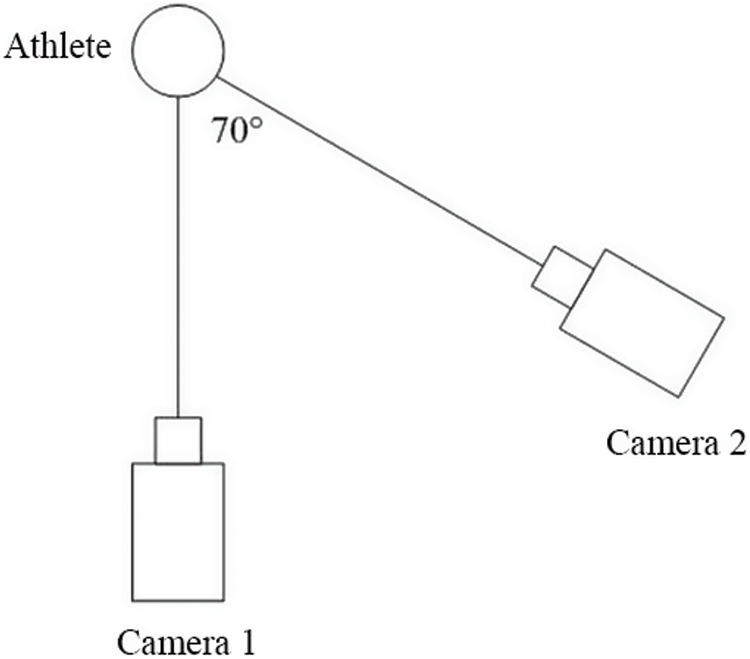
Figure 1: Shooting site
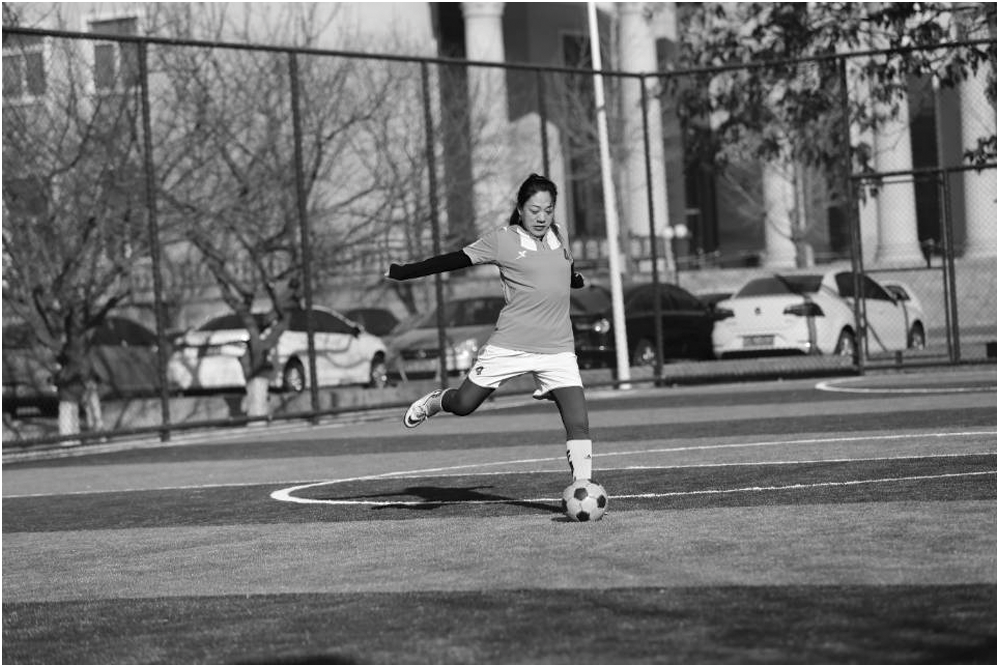
Figure 2: Place kick with the inner edge of the instep
2.3 Data Processing and Analysis
The captured video was processed by the German SIMIO motion 7.3 three-dimensional video analysis software. The Hannanvan human figure model was used for image sampling and data calculation, and the digital filtering method was used for smoothing [19]. The processed data were input into Excel and processed in SPSS17.0. T-test was used for differences between groups. If P < 0.05, there was a significant difference. Corresponding graphs and tables were made in Excel to show the experimental results.
In the process of kicking, the kicking leg of the athlete swung backward first and then forward. The comparison of the swing time between the two groups is shown in Fig. 3.

Figure 3: Comparison of the swing time of the kicking leg
*Group A had a significant difference with group B (P < 0.05).
It was seen from Fig. 3 that the two groups had significant differences in swing time. In the process of kicking, the kicking leg swung forward from the back, and the thigh and calf folded to provide momentum for kicking. When the thigh stopped backswing, the leg was still swinging backward; therefore, the forward swing time of the thigh was longer than that of the calf. In comparison, the swing time of group A was significantly shorter than that of group B, and the forward swing time of the thigh was longer than that of the calf, which provided a greater kicking speed for the calf.
The swing amplitude of the kicking leg was compared between the two groups, and the results are shown in Fig. 4.
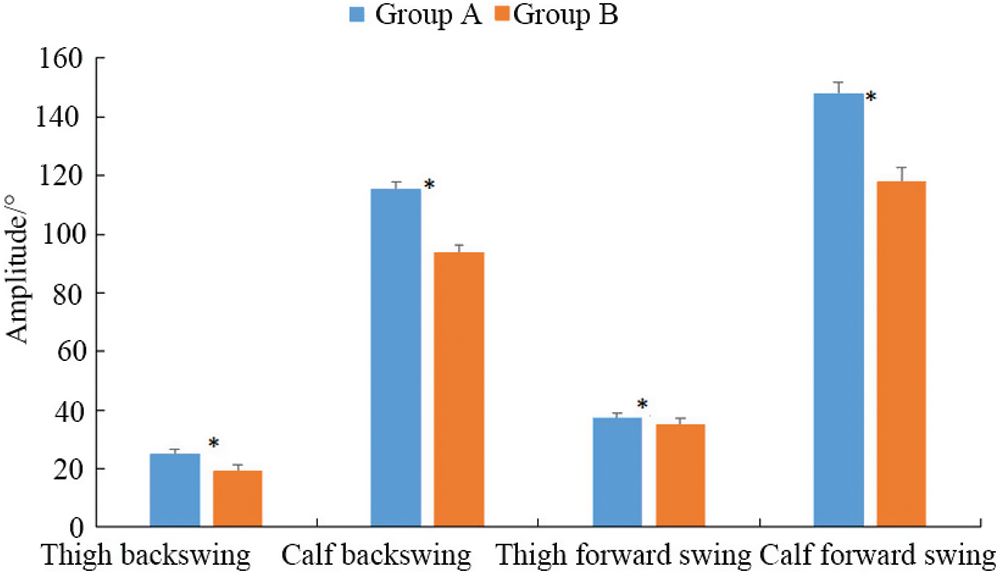
Figure 4: Comparison of the swing amplitude of the kicking leg
Note: *Group A had a significant difference with group B (P < 0.05).
It was seen from Fig. 4 that the thigh backswing amplitude of group A was 25.12 ± 1.36°, larger than that of group B (P < 0.05). The kicking leg of group A had a greater degree of an extension, which was more conducive to get a greater forward swing speed to make a strong shot. The calf backswing amplitude of group A was 115.24 ± 2.78°, which was also significantly larger than that of group B; in this stage, the folding of the thigh and calf of group A was more obvious, and the strength was larger. The forward swing amplitude of group A was also significantly larger than that of group B; in this stage, the thigh had a better braking deceleration effect, the calf flexed more, and the folding of the thigh and calf was more sufficient, which provided better preparation for the explosive acceleration of calf to ensure greater kicking strength.
The acceleration of the kicking leg was compared between the two groups, as shown in Fig. 5.
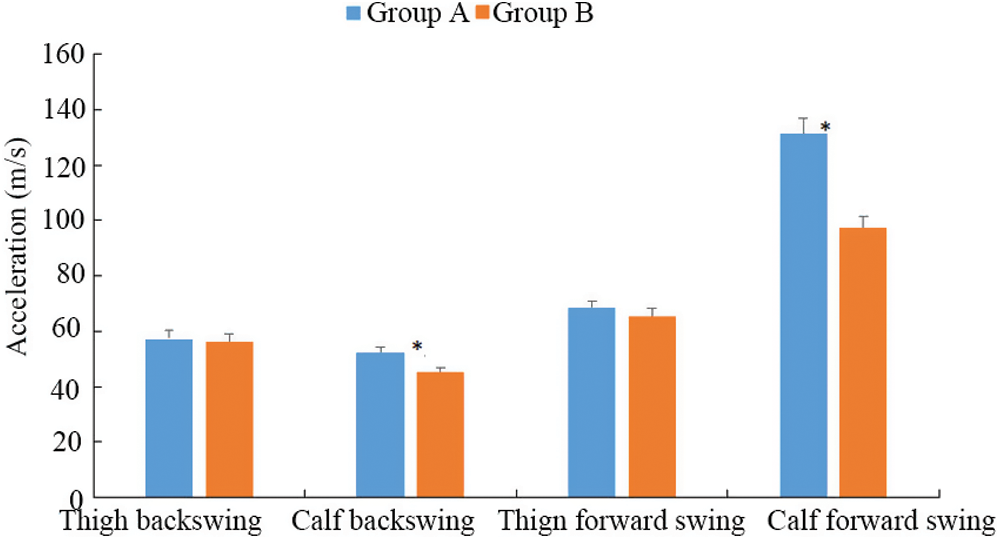
Figure 5: Comparison of the acceleration of the kicking leg
Note: *Group A had a significant difference with group B (P < 0.05).
It was seen from Fig. 5 that there was no significant difference in thigh acceleration between the two groups (P > 0.05), but the acceleration of group A was slightly greater than that of group B. The calf acceleration of group A was significantly greater than that of group B (P < 0.05). The greater the acceleration was, the greater the potential energy provided was, and the greater the strength and speed of hitting the ball were.
The angular velocity when the athletes in the two groups swung forward was compared, and the results are shown in Fig. 6.
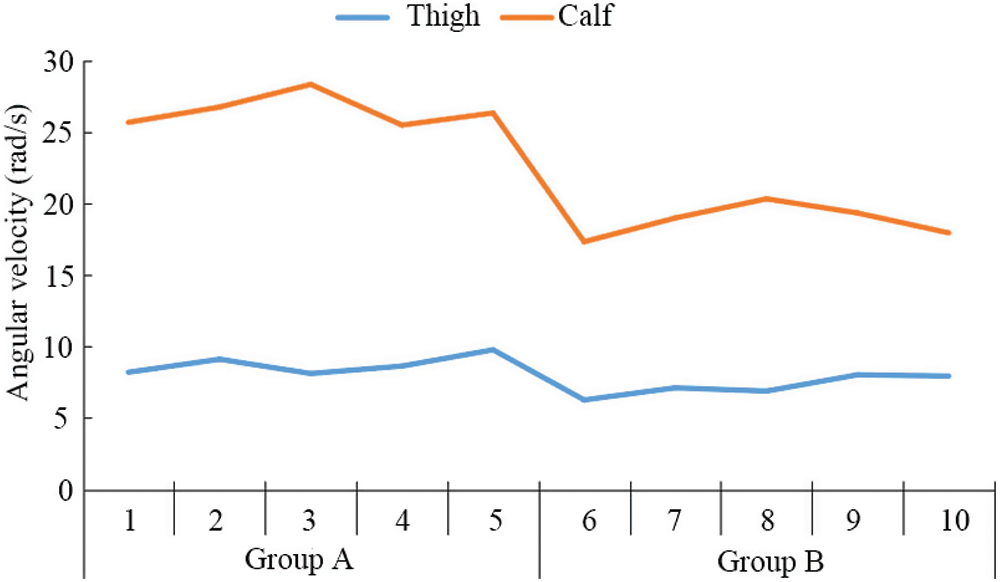
Figure 6: Comparison of the forward swing angular velocity of the kicking leg
It was seen from Fig. 6 that when swinging forward, the angular velocity of the thigh of the kicking leg was smaller than that of the calf, which was because the kicking leg had the characteristics of whipping action and the strength and speed were transferred from the thigh to the calf. By comparison, the angular velocity of the forward swing of group A was greater than that of group B, and the difference in the calf was more significant. The average angular velocity of the two groups was calculated, as shown in Table 2.

It was seen from Table 2 that the average value of the thigh forward swing in group A was 8.77 ± 0.78 rad/s, and the average value of the calf forward swing in group A was 26.51 ± 2.11 rad/s, which were significantly higher than those in group B (P < 0.05). The swing amplitude of the kicking leg in group A was larger, which provided a greater angular velocity for the forward swing after layer by layer transmission and reached the foot to provide a greater ball speed for kicking.
According to the anatomical posture (Fig. 7), the angle and angular velocity of the ankle joint in three-dimensional space at the time of touching the ball were compared between the two groups, as shown in Table 3.

Figure 7: Human leg anatomical posture

It was seen from Table 3 that the angle of group A on the sagittal axis was significantly greater than that of group B (P < 0.05), and the angular velocity of group A on the sagittal axis was also larger than that of group B (P < 0.05). In kicking, the ankle joint mainly moved around the sagittal axis, and the amplitude of motion on the other two axes was very small; therefore, the difference was not significant. The difference on the sagittal axis showed that athletes in group A had greater strength and level.
Kicking the ball with the inner edge of the instep is a complex technique, which will have a great influence on the kicking power and nature. In the process of kicking the ball with the inner edge of the instep, the swing of the kicking leg is very important. The swing of the kicking leg is almost synchronous with the support stage. A long swing distance provides kinetic energy for the final hitting moment. In the swing process, the thigh and calf swing back and forward in turn to form momentum transfer and complete the hit. The comparison of athletes at different levels showed that the high-level athletes (group A) had significantly shorter swing time; they got higher swing speed through shorter swing time, thus improving the strength of kicking. It was also found that the calf of the high-level athletes remained a backswing state after the thigh ended the backswing, and the thigh began to swing forward, which made the folding of the thigh and calf more sufficient and made the calf obtain a higher speed when swinging forward. The amplitude of the kicking leg of group A was significantly larger than that of group B (P < 0.05). In the perspective of the level of athletes in the two groups, athletes in group A who had higher level had stronger muscle power and leg muscle contractility; therefore, they could give full play to the muscle power and provide a large forward swing space while swinging backward, which was more conducive to realize high-quality hitting. In the perspective of swing speed, the high-level athletes obtained a large inertia force after sufficient pedal and stretch, and then the kicking leg swung backward to contract the muscle group and swung forward to obtain a large acceleration and transfer it to the ankle joint. In conclusion, the variation of time, amplitude, and speed were closely related in the swing process of the kicking leg, and high-level athletes obtained larger speed through larger motion amplitude in a shorter time, creating favorable conditions for kicking. From this point of view, during daily training, athletes should stretch with force to fully extend the thighs and calves and increase the backswing amplitude and speed of the thighs.
The comparison of ankle joint characteristics showed that the difference in athletes with different levels was that the angle and angular velocity of the ankle joint of athletes with higher levels were greater in the sagittal plane when the athletes were touching the ball. In the process of action, the athletes did not have a great movement in the vertical axis, the movement on the coronal axis that was opposite to the direction of hitting the ball also had no large change, and the movement on the sagittal axis that was the same as the direction of hitting the ball changed. Therefore, the differences in the ankle joint were mainly reflected in the sagittal axis, and high-level athletes had large ankle angle and angular velocity, providing more power to hitting. Based on the above results, athletes should pay more attention to the position of the hip, knee and ankle joints of the swing leg when touching the ball in the training process, so as to complete the technical movements better.
This paper has obtained some results in the study of kicking the ball with the inner edge of the instep; however, there are some limitations. For example, the sample size was small, only male football players were studied, the characteristics of the inner edge of the instep of female football players and the influence of gender on the biomechanical characteristics of kicking the ball with the inner edge of the instep were not considered, and there was no in-depth analysis of muscle mechanics, all of which need to be addressed in future research.
Currently, there are fewer studies on the biomechanical analysis of a particular movement in football. This study compared the biomechanical characteristics of athletes with different levels when kicking the ball with the inner edge of the instep. The results showed that:
(1) The swing time of group A was shorter than that of group B (P < 0.05);
(2) The backward swing and forward swing amplitudes of the thigh and calf in group A were greater than those in group B (P < 0.05);
(3) The acceleration of the calf swing in group A was significantly larger than that in group B (P < 0.05);
(4) The angular velocity of group A was larger than that of group B (P < 0.05);
(5) When touching the ball, the ankle angle and angular velocity of group A were larger than those of group B on the sagittal axis (P < 0.05).
The experimental results reveal the differences in athletes with different levels. This article provides some references for how to improve the technical level of athletes, contributes to the further research of kicking the ball with the inner edge of the instep, and offers some theoretical bases for the research of the technique and even more football techniques to expand the in-depth research in the field of football techniques. This study is helpful for coaches to find out the shortcomings and provide targeted guidance and also beneficial for athletes to better understand the gap between themselves and high-level athletes and make reasonable improvements and training to improve the technical level.
Funding Statement: The author received no specific funding for this study.
Conflicts of Interest: The author declares that they have no conflicts of interest to report regarding the present study.
1. Fleisig, G. S. (2018). Editorial commentary: Changing times in sports biomechanics: Baseball pitching injuries and emerging wearable technology. Arthroscopy, 34(3), 823–824. DOI 10.1016/j.arthro.2017.11.004. [Google Scholar] [CrossRef]
2. Bandeiras, C. (2020). Technology in sports biomechanics. IEEE Potentials, 38(3), 8–10. DOI 10.1109/MPOT.2019.2897276. [Google Scholar] [CrossRef]
3. Liu, Y., Zhu, T. (2020). Individualized new teaching mode for sports biomechanics based on big data. International Journal of Emerging Technologies in Learning (iJET), 15(20), 130. DOI 10.3991/ijet.v15i20.17401. [Google Scholar] [CrossRef]
4. An, W. C., Ngali, M. Z., Kaharuddin, Z., Razak, S. B. K. (2017). Performance of dual depth camera motion capture system for athletes’ biomechanics analysis. MATEC Web of Conferences, 135(4), 00059. [Google Scholar]
5. Taborri, J., Keogh, J., Kos, A., Santuz, A., Umek, A. et al. (2020). Sport biomechanics applications using inertial, force, and EMG sensors: A literature overview. Applied Bionics and Biomechanics, 2020(7), 1–18. DOI 10.1155/2020/2041549. [Google Scholar] [CrossRef]
6. Howard, R. M., Conway, R., Harrison, A. J. (2016). A survey of sensor devices: Use in sports biomechanics. Sports Biomechanics, 15(4), 450–461. DOI 10.1080/14763141.2016.1174289. [Google Scholar] [CrossRef]
7. García-Ramos, A., Stirn, I., Strojnik, V., Padial, P., de la Fuente, B. et al. (2016). Comparison of the force-, velocity-, and power-time curves recorded with a force plate and a linear velocity transducer. Sports Biomechanics, 2016, 329. DOI 10.1080/14763141.2016.1161821. [Google Scholar] [CrossRef]
8. Peterson Silveira, R., Stergiou, P., Carpes, F. P., Castro, F. A. S., Katz, L. et al. (2016). Validity of a portable force platform for assessing biomechanical parameters in three different tasks. Sports Biomechanics, 16(2), 177–186. [Google Scholar]
9. Wang, W., Li, Y. L. (2021). Study on treatment and rehabilitation training of ligament injury of javelin throwers based on sports biomechanics. Measurement, 171, 108757. DOI 10.1016/j.measurement.2020.108757. [Google Scholar] [CrossRef]
10. Stephens, N., Ng, L., Wild, C., Williams, S., Klem, N. R. (2017). Effect of prophylactic ankle taping on ankle and knee biomechanics during basketball-specific tasks. Physical Therapy in Sport, 20(1), e61–e62. [Google Scholar]
11. Gillet, B., Isabelle, R., Elodie, M. D., Mickaël, B. (2019). Lower trapezius weakness and shoulder complex biomechanics during the tennis serve. Medicine & Science in Sports & Exercise, 51(12), 2531–2539. [Google Scholar]
12. Mccabe, C. B., Sanders, R. H., Psycharakis, S. G. (2015). Upper limb kinematic differences between breathing and non-breathing conditions in front crawl sprint swimming. Journal of Biomechanics, 48(15), 3995–4001. [Google Scholar]
13. Mann, J. B., Ivey, P. A., Sayers, S. P. (2015). Velocity-based training in football. Strength & Conditioning Journal, 37(6), 52–57. [Google Scholar]
14. Merchan-Osorio, R. D., Florez-Florez, J., Caro-Cely, W. F. (2019). Soccer teaching methods in sports training schools in Tunja, Boyacá. Journal of Physics: Conference Series, vol. 1161, no. 1, pp. 012008. IOP Publishing. [Google Scholar]
15. Carpita, M., Sandri, M., Simonetto, A., Zuccolotto, P. (2015). Discovering the drivers of football match outcomes with data mining. Quality Technology & Quantitative Management, 12(4), 561–577. [Google Scholar]
16. Rathke, A. (2017). An examination of expected goals and shot efficiency in soccer. Journal of Human Sport & Exercise, 12(Proc2), 514–529. [Google Scholar]
17. Nédélec, M., Leduc, C., Dawson, B., Guilhem, G., Dupont, G. (2017). Case study: Sleep and injury in elite soccer. A mixed method approach. Journal of Strength & Conditioning Research, 2017, 1. [Google Scholar]
18. Ekstrand, J., Waldén, M., Hägglund, M. (2016). Hamstring injuries have increased by 4% annually in men’s professional football, since 2001: A 13-year longitudinal analysis of the UEFA elite club injury study. British Journal of Sports Medicine, 50(12), 731–737. [Google Scholar]
19. Eswarappa, C., Hoefer, W. J. R. (2015). Fast S-parameter computation of a microstrip interdigital filter using TLM, Prony’s and digital filtering techniques. International Journal of Numerical Modelling Electronic Networks Devices and Fields, 9(3), 237–248. [Google Scholar]
 | This work is licensed under a Creative Commons Attribution 4.0 International License, which permits unrestricted use, distribution, and reproduction in any medium, provided the original work is properly cited. |